thomas simmonds
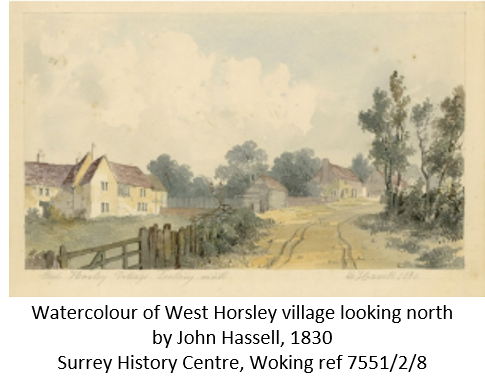
Subject : Thomas Simmonds (b 1808 – d 1885)
Researchers : Julie Cameron & Sue Driscoll
‘Ag lab’ to woodworker late in life for West Horsley widower
Thomas Simmonds, an agricultural labourer from West Horsley, suffered the early loss of a son in a terrible accident and then his wife though illness. He also lost three of his grandchildren in just eight days through scarlet fever. Thomas remained close with two of his sons, with all of them turning to careers working with wood, despite Thomas being around 70 years of age.
West Horsley all his life
 Thomas Simmonds was born in Spring 1808 in West Horsley, Surrey and baptised in May that year in the village’s St Mary’s Church 1. He was the fifth of eight known children for James and Elizabeth 2. Thomas’ father was a shoemaker by trade, and by the time of the baptism of his last child, was also a parish clerk.
Thomas Simmonds was born in Spring 1808 in West Horsley, Surrey and baptised in May that year in the village’s St Mary’s Church 1. He was the fifth of eight known children for James and Elizabeth 2. Thomas’ father was a shoemaker by trade, and by the time of the baptism of his last child, was also a parish clerk.
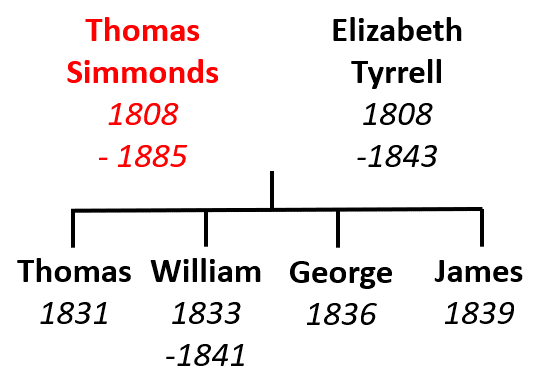 At the age of 22, Thomas married Elizabeth Tyrrell in May 1830 in West Horsley 3. Elizabeth was a similar age, born in January 1808, and came from East Horsley 4.
At the age of 22, Thomas married Elizabeth Tyrrell in May 1830 in West Horsley 3. Elizabeth was a similar age, born in January 1808, and came from East Horsley 4.
The couple made their home in West Horsley, having four sons within the next nine years 5.
Death of child and wife
In June 1841 agricultural labourer Thomas, wife Elizabeth, and their sons Thomas, William, George and James, were living at ‘Street’, West Horsley 6. Not long after this, the family suffered two terrible blows.
The first was in November 1841 when 8-year-old William was ‘accidentally burnt to death’ 7. A coroner’s inquest took place, but there are no records available to detail exactly what happened.
Two years later, Thomas’s wife Elizabeth died in December 1843 from an ‘abscess on the head’, aged 35 8.
Thomas now had three sons to provide for, although the eldest, 12-year-old Thomas, would by now almost certainly have been working as an agricultural labourer like his father.
The 1851 Census showed that Thomas had managed to keep his boys with him in West Horsley, all now employed as agricultural labourers 9, 10. Thomas senior was living with youngest sons George and James, while his eldest son Thomas junior was lodging next door with 60-year-old Hannah Edes and her family.
Ten years later, all four men were still in West Horsley and still agricultural labourers. Thomas senior was lodging in Chalk Pit 11. Thomas junior was living in Silkmore Lane with his wife Caroline and new-born child, and boarding with them was his younger brother James 12. George was lodging with Hannah Edes in The Street 13.
Scarlet fever wipes out 3 grandchildren in a week
By the summer of 1864, Thomas junior and his wife Caroline had three children 14. However, the young family were struck a savage blow in April 1867 when all three of the children – 2-year-old James, then Fred aged 6, followed by George, 5 – died within just eight days of each other from scarlet fever 15. With no antibiotics developed at that time, scarlet fever was one of the deadliest infections of the Victorian era.
Thomas and Caroline had two more children by the time of the 1871 Census and were still living in West Horsley with his brother James 16. Father Thomas was close by in the village, lodging with Hannah Edes 17.
Struggles for son George
While Thomas, Thomas and James worked on the land as farm labourers, George signed up in 1855 with the local 2nd Royal Surrey Militia Regiment, and then in 1857 for the 3rd Regiment of Foot of the regular Army 18. He served in Malta and India, before being declared unfit for further service due to ‘loss of vision of right eye’ in 1860, and returning to West Horsley.
It is not clear what happened to George in the following years. He may well having 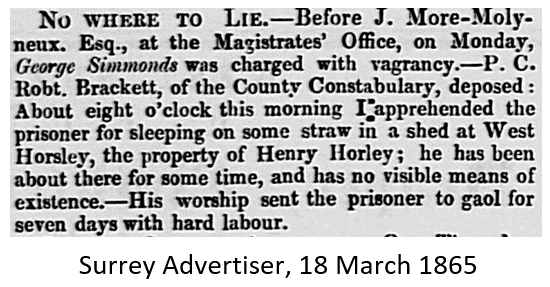 been living rough, as a George Simmonds was charged with vagrancy in West Horsley in 1865 19. A more certain record for him from December 1867 showed that George, ’blind in his right eye’, had been imprisoned in Wandsworth Gaol for trespassing 20.
been living rough, as a George Simmonds was charged with vagrancy in West Horsley in 1865 19. A more certain record for him from December 1867 showed that George, ’blind in his right eye’, had been imprisoned in Wandsworth Gaol for trespassing 20.
A change of career
When Thomas senior’s youngest son James married on Christmas Eve 1875 in West Horsley, both James and his father were recorded on the certificate as labourers 21. Not long after this it appears that James, his brother Thomas and even their father Thomas himself had changed careers and began working with wood.
In 1877 and then again in 1880, Thomas junior was recorded as a ‘carpenter’ on two of his children’s baptism records, and on the 1881 Census 22, 23. James was listed in the same census as a ‘hoop shaver’, involved in the manufacture of barrels 24, 25. 73-year-old Thomas senior was noted on the same Census as being a ‘wheelwright’, a skilled occupation working alongside a blacksmith to manufacture wheels 26, 27.
Although there are no available records before 1877 showing the Simmonds trio working with wood, it seems certain that they must have all been proficient to have been able to earn a living this way. However, on the day of the 1881 Census, Thomas senior was not working, as he was an inmate of the Guildford Union Workhouse, listed next to his younger brother William.
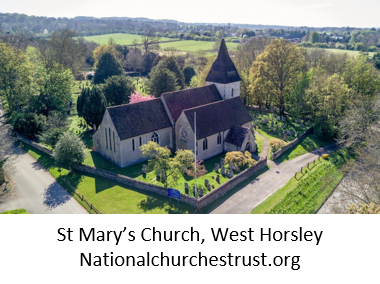 There are no admission or discharge records available for the Guildford Union Workhouse to indicate when Thomas first entered the Workhouse, and whether he remained as a long-term inmate, but on 1st August 1885, he passed away there, aged 78 28. His death certificate called him a ‘carpenter of West Horsley’, and he was buried at St Mary’s Church four days later 29.
There are no admission or discharge records available for the Guildford Union Workhouse to indicate when Thomas first entered the Workhouse, and whether he remained as a long-term inmate, but on 1st August 1885, he passed away there, aged 78 28. His death certificate called him a ‘carpenter of West Horsley’, and he was buried at St Mary’s Church four days later 29.
April 2023, updated November 2025
Editor: Mike Brock
We’d love to hear from you if you are a relative of Thomas Simmonds. Please contact us by email at spikelives@charlotteville.co.uk
Sources and References
Original Surrey parish records are available at the Surrey History Centre, Woking. Digitised parish records were sourced through Ancestry.co.uk. A complete list may be found here Thomas Simmonds references
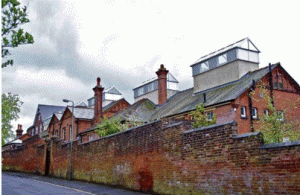 Spike Lives is a Heritage project that chronicles the lives of inmates, staff and the Board of Guardians of the Guildford Union Workhouse at the time of the 1881 Census. The Spike Heritage Museum in Guildford offers guided tours which present a unique opportunity to discover what life was like in the Casual/Vagrant ward of a Workhouse. More information can be found here
Spike Lives is a Heritage project that chronicles the lives of inmates, staff and the Board of Guardians of the Guildford Union Workhouse at the time of the 1881 Census. The Spike Heritage Museum in Guildford offers guided tours which present a unique opportunity to discover what life was like in the Casual/Vagrant ward of a Workhouse. More information can be found here
